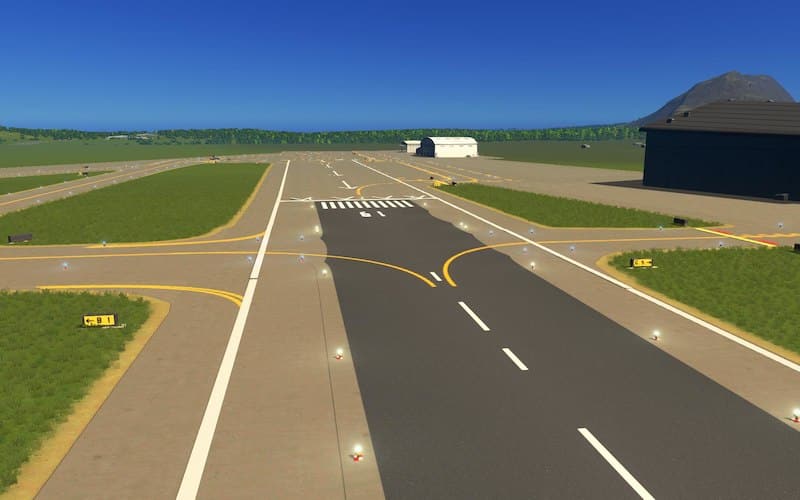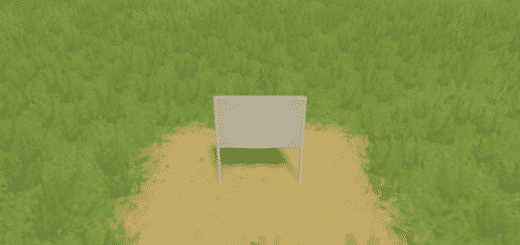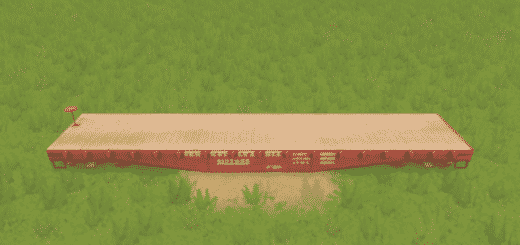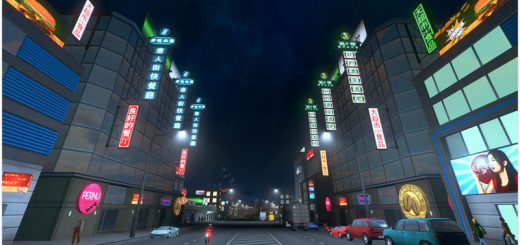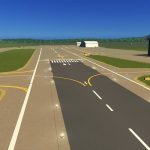
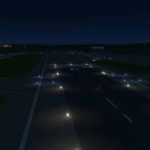
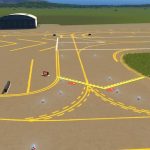
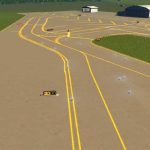
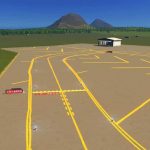
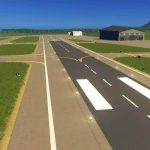
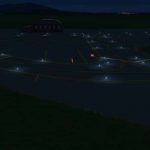
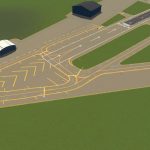
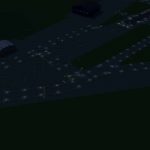
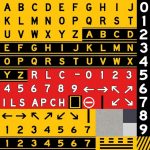
Taxiway Sign Pack
Thick pack is a very large download (the last update was 208 MB). Note that if you have the advanced loading screen mod enabled with texture sharing, this should only consume less than 5 MB RAM / VRAM.
Additionally, these signs are very small and hard to place. We settled on this size as it was the best compromise between astetics and what was reasonable in the game.
Finally, to place these correctly (the correct locations and contents), for a small airport, will most likely take several days, let alone a large international airport. We underestimated the time it would take to place them (the screenshots are only in a small 600 meter x 300 meter section of an example airport. Though the results are worth the time / effort.
This is a prop collection of modular taxiway signs for use with airports. These props were designed so that they can be clipped into each other to form most signs that can be found at modern airports. Due to the sign size though, and the fact that misalignment is easily seen, we recommend using the prop precision mod.
These props do have an illumination map, so they will light up at night (real taxiway signs will have backlights in them so that pilots can read them at night).
Because of the way the game deals with LODs, we recommend that you use the adaptive prop visibility mod to make the signs visible at moderate distances, otherwise they will partially dissapear.
All sign models share the same texture Diffuse, Specular, Illumination, which is 512×512. For this reason, we highly recommend using the advanced loading screen mod, to ensure that the texture is only loaded once by the game.
For model, the main models range from 32-28 Tris, with an LOD between ranging from 10-8 Tris.
The ground models share the same diffuse texture, which is 1024×1024, with an LOD texture that is 128×128. All of the models are 10 Tris with a 2 Tri LOD.
- Crossing Taxiway sign (Black on Yellow): A-Z, 1-7, 6 Arrows, separator
- Taxiway Location sign (Yellow on Black): A-Z, 1-7, end brackets ( [ and ] )
- Runway sign (Red): 0-9, R,L,C, 6 Arrows, separator [sign and ground]
- Runway distance remaining sign (White on Black): 0-9
- APCH sign [sign and ground]
- ILS sign [sign and ground]
- Hold short sign
- Do not enter sign
- End of taxiway sign
- Sign end caps (left and right side)
These signs are placed along side a taxiway and / or runway, typically at intersections.
If you are going to place these for your airport, we would suggest that you either “plan out” your airport, or look for an aviation map of the airport you are basing yours off of. Each Taxiway section should receive its own letter (just like streets have their own name), if there are more than 23 Taxiways, they will begin to double up (e.g. AA, BB, etc.). Note that letters ‘O’, ‘I’, and ‘X’ are never used (they can be confused for other symbols), and that double lettered taxiways are never found (i.e. AB is not allowed). Often airports will denote “stub taxiways” with letter/number pairs. For example, if taxiway A runs parallel to runway 4-22, then all of the connections between 4-22 and A, which do not connect to other taxiways (i.e. stubs) will be called A1, A2, A3, etc.
Here is a short description of the sign types:
- Taxiway Location sign (Yellow on Black): These designate what taxiway the aircraft is currently on. and will be surrounded by a yellow boarder. For example, if the aircraft is on taxiway A, then any signs that the aircraft come across will have an [A] on them (with the brackets).
- Crossing Taxiway sign (Black on Yellow): These designate taxiway intersections (like cross streets), and will have directional information. Here are two examples:
1) + intersection, between taxiway A and B, the aircraft is on taxiway A. The Sign would read [A] <- B ->, which denotes that B is cross A.
2) T intersection, between taxiway A (horizontal) and B (vertical), the aircraft is on taxiway A. The sign would read [A] B ->, or <- B [A] , depending on which direction the aircraft is coming from. - Runway sign (Red): These denote runway intersection, and will list the runways from left to right. For example, if there is a crossing between taxiway A and runway 4-22, the sign would read [A] 4-22. (RLC would be added, such as 4R-22L). Note that if the taxiway intersects at the END of a runway, it will only have the number of the runway from that sign (e.g. [A] 4).
- APCH sign: These are placed at hold-short lines for taxiway that cross a runway approach. So for example, if the taxiway crosses BEHIND runway 4 (i.e. goes across the path that an approaching aircraft takes), there will be a sign that reads 4-APCH
- Separators: These are used to separate multiple parts of the sign. For example, if there is a + intersection, there left side is B, the vertical line is A, and the right side is C. Then an aircraft on A would see <- D [A] <- B | C ->, or <- C [A] B -> | D -> , depending on the incoming direction.
- Runway distance remaining sign (White on Black): These denote the distance remaining until the end of the runway, which are in 1000 foot increments. So for example, 2000 feet remaining would be a sign that reads ‘2’.
- ILS sign: These are placed along side ILS hold markings, which indicate that aircraft should hold here whe an aircraft is on approach / landing. If the aircraft were the proceed, it would interfere with the ILS antenna, and either cause the signal for the landing aircraft to go dead, or become garbage.
- Hold short sign: These are used on the taxiway side heading off of a runway, to indicate that there is a hold short point. As an example, Taxiway A crosses Runway 4-22, with the runway ahead, there will be a sign [A] 4-22, near the hold short point. On the other side, runway behind, there will be a hold short sign.
- Do not enter sign: These are used to mark out to aircraft and other vehicles that they cannot continue forward on the pavement. These are often used at older airports which have unmaintained pavement which is not capable of supporting vehicle or aircraft weight (or has a lot of pot holes which could be hazardus to aircraft landing gear).
- End of taxiway sign: These are placed at the end of a taxiway to denote that it ends there. In the above example with the T intersection, with B being on the vertical. Across the intersection, one of these signs would appear to tell pilots that they must turn / cannot continue forward.
A quick reference can be found here (1 page with figures):
More exampls can be found here (18 pages, mostly figures):
More extended reference (starts on page 17, PDF page 23):
More information on taxiway nomenclature can be found here (4 page PDF in list / bullet form):
If you have any questions, or need further clarification, please post a comment below.

